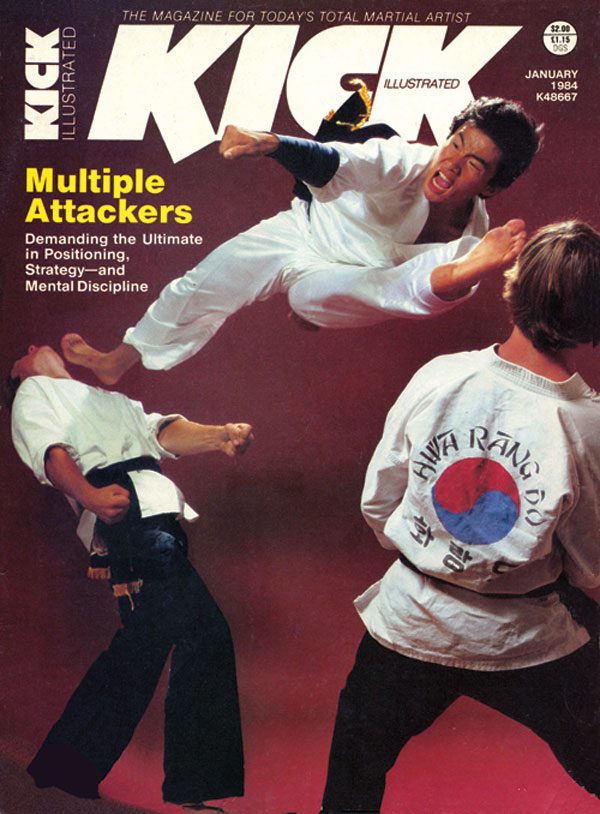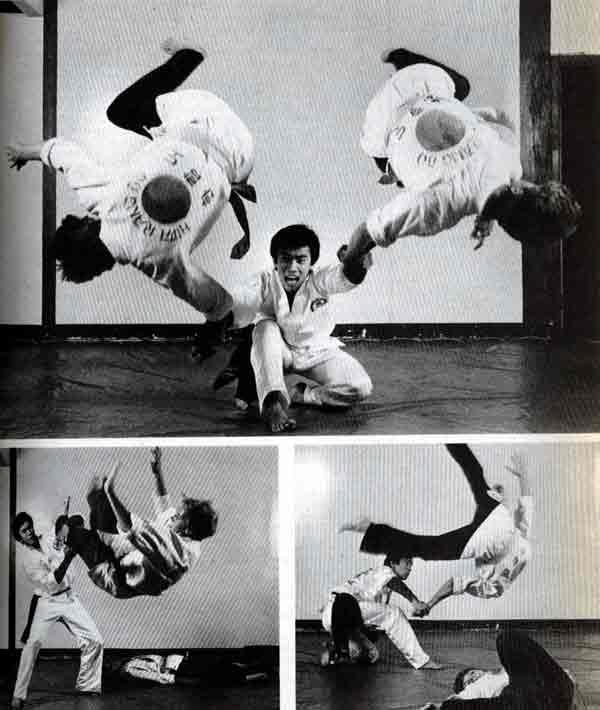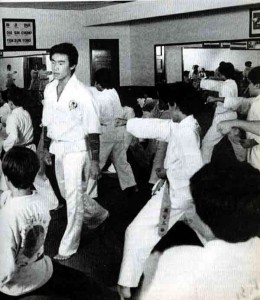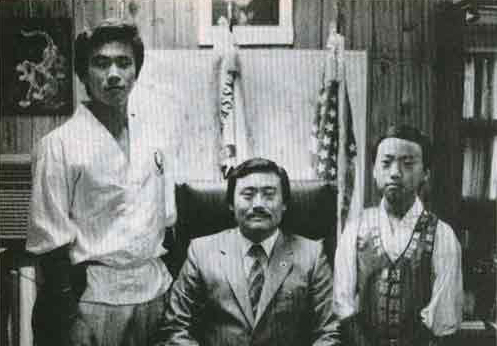His First Magazine Cover and Interview with then Young Grandmaster Taejoon Lee – at the time going by his American name Henry Lee.
At the World Headquarters of the World Hwa Rang Do® Association, the dojang reverberates with the sounds of thrown bodies striking the mat. Fresh from classes at the University of Southern California, Henry Lee, the son of Hwa Rang Do® Founder (DoJooNim) Dr. Joo Bang Lee, is putting the evening classes through its paces.
“Step right there,” he cautions a very young student. “Remember to go with me on the throw or you’ll hurt yourself.” Having given the youngster some advice on learning back falls, Lee slides forward and the young student goes spinning over to land flat on his back. “See, nothing to learning how to fall-at first,” Lee grins.
Henry Lee has been a martial artist for most of his short life. Currently attending USC, where he’s majoring in business, Lee eventually hopes to attend an Ivy League school. At the moment, his future plans include combining a study of law with a study of business. Lee also possesses what he readily admits as “a rather optimistic view of life.” And in the quiet that followed the evening class, he sat down and began to discuss not martial technique, but the meaning to martial art-and its ability to alter lives for the better-particularly, as Lee sees it, the lives of his own generation. After all, as Lee pointed out, “Hwa Rang Do is an art that is not proud of its techniques – it’s an art that’s proud of its discipline and traditionalist ways. Hwa Rang Do is not a person who brags about how hard he punches or about how many boards he breaks. No, Hwa Rang Do is a person who is proud of the way he conducts his life understanding the nature of humanity in general. And I’m sure,” Lee adds, “that that’s true about all traditional martial art schools.” To Lee Hwa Rang Do represents not a way of fighting, but a way of living a productive, disciplined life. And he sees that as the biggest boon martial art-whatever the style or tradition- has to offer his generation. It’s a view that’s been reinforced within the context of his own life. “For the younger generation especially,” he remarks, there is a need for some type of guidance – they need something they can use to lead their lives. It’s good to talk about freedom and independence, but when you’re young it’s very helpful to have someone to tell you, you must do this and that to attain your goals” – whatever those goals may be. There is a need for structure and discipline to inform you that you can attain the goals you set. “A lot of young people today are kind of reluctant to decide on what they want to do in the future…or they wander aimlessly, drifting into things because they ‘do it for today.’ They enjoy the moment. “Well, I believe that what Hwa Rang Do does is reinforce the idea that there are goals that one seeks to attain – and it teaches you how to attain that goal, how to have the courage to persevere in reaching the goal. It’s like the metaphor of life as an unpaved country road: It’s not always straight; there are detours to take; sometimes life is a rocky road filled with pain… or adversity. Even though those challenges arise and one has to confront adversity, Hwa Rang Do teaches you to overcome them, to strive and move forward.”
Lee pauses a moment, and then reflects, “I know I went through that awkward adolescent stage. But I grew out of it very quickly. For me, that change came about when I began teaching my art. I started when I was fourteen – and the experience matured me rather quickly. In a sense, it helped me abandon my childhood and become an adult.”
Lee is quick to point out in his view, “age does not matter in a person-if the person is able to look at life and put it into perspective and see and extract all the possibilities that exist. To see one facet of one object and say, “that is that and that’s all there is,” is to hold a naive or ignorant viewpoint. But to look at life from all points of view…that’s the hallmark of a wise or mature individual.” Lee observes, “the same is true about arts. Just like Hwa Rang Do: Take it and examine it from one angle and you have one picture. Take Hwa Rang Do and turn it, so to speak, and you’ll find a new picture – a new side. It’s like a cube – or a gem – turn it in your hands and with every turn you’ll find a new facet. “I relate that as being true of life,” Lee says. “Look at it from all the angles – not just your own. And I think that’s what helped me grow out of my awkward stage.”
The key to Hwa Rang Do’s ability to alter one’s life for the better is a key shared by all martial art – a view Lee endorses. “Hwa Rang Do also teaches one to discipline oneself, to put one’s life in order, and not to allow trite things to defeat oneself or to lure one into self-deceit. And of course, it bestows confidence and self assurance that one can struggle and work hard and attain a personal goal.” Hwa Rang Do’s philosophical core is embodied in a code of ethics, Lee points out. “We have five principles in our ethical code: loyalty to one’s country; loyalty to one’s parents and teachers; trust and brotherhood among friends; courage – never to retreat in the face of the enemy; and justice – never to take a life without a cause.” “When you examine these ethics closely,” Lee adds, “you see that they provide one with a definite structure – a way to live life. And it’s important to remember that the ethics go beyond a literal meaning. Take the forth ethic. “Courage – never to retreat in the face of the enemy.” You can say it pertains to fighting, but it pertains to homework, or ones job, or ones way of conducting any relationship – personal or professional. That ethic is describing the will persevere, to overcome the difficulties confronting you and not to retreat into self-defeat.” Lee also credits the very atmosphere of a martial arts school as being a primary cause in restructuring one’s life and attitudes. “The atmosphere in our class is warm and friendly – but discipline and respect are there at the same time. I’m sure that’s true about most studios.” As he points out: “I think as you age, life can teach you that you need to be stern and hard and not trusting of other people. But when you enter the studio, all those outside influences are gone. You do trust the individual next to you – even though you may have not trusted him outside. When you first meet a person, you don’t automatically extend your trust or your care. But when you enter the studio and meet a person, those qualities come out very quickly. Because in the studio you know you’re not going to try to hurt one another – you’re there to learn, and learn together.” Lee returned to his point on the benefits of martial art for the younger generation. “The present generation was once young – they have tasted adversity, they have struggled and attained success – failure in some cases. To build a better future, it is necessary to raise and nurture the young generation – to teach it that it can succeed in the future. I think Hwa Rang Do, and martial arts in general, teaches youths how to channel their energy into attaining a better future.”
Lee reminisces for a moment. “I had a student who was in my class – he was an ‘F’ student in school. But after studying for a few month’s, you could see his whole attitude changing. He was no longer satisfied with failure. And now he’s going to college – to Cal Tech. I had another student who was being held back a grade. Studying Hwa Rang Do changed his attitude too – and he’s not being held back anymore. “Those are the satisfying moments – that’s what makes me proud as a teacher and a practitioner of my art.” Lee’s conversation raises an interesting point – one that’s been mentioned by other practitioners in the past – how becoming an instructor leads to improvement and change in one’s own art. “Most definitely,” Lee nods. “You certainly do grow. I look back and see an evolution from year to year. “You know, it’s often – stated bit of philosophy that the only thing in the universe that is permanent is change. I look back over four years, and I wonder if I should have done things a little differently. But I try to be always open-minded about change. I’m sure in 10 or 20 years, certain ideas of mine will have changed – but I think the fundamental ideas will remain the same. And that’s Hwa Rang Do.”
Lee repeats his earlier point: “Hwa Rang Do is understanding natural laws and living with a deep understanding and appreciation of humanity. That is more important than any technique – and we have over 4,000. And that’s the point that gets across to students, whether young or old – it’s the one aspect they perceive quickly.” But what about the young student who walks in, his mind filled with pictures of his physical ability and fighting? Not everyone responds to the philosophy and ethics of martial art – or to discipline and respect. Lee acknowledges the point with a laugh. It’s a situation that he not unfamiliar with. “At that point, anything you tell the student about mental and spiritual aspects of martial art will pass right over his head. He doesn’t want to listen to that. But after he’s in the class for about three weeks, he’ll start to notice the difference in his attitude and the attitude of the other student. He will change himself automatically. You don’t need to lecture.” The same thing is true of resect. It’s hard to say to a new student: “You respect me” – and have that student respect you. So I let that point pass. As they watch me in class – and the other students senior to them – and see what we can do – respect comes then. It’s must be a natural process.”
Attitude, Technique, and Multiple Assailants Lee’s evening class had concluded with a demonstration of techniques against multiple attackers. The conversation then turned to technical aspects – most directly to confronting multiple attackers.
Lee’s answer harked back to points of his earlier conversation. “It’s a question of attitude and awareness and self-confidence – not technique. After all, by the time you even begin to spar for developing a sense of distance and timing, you already have your fundamental techniques. “Confronting multiple attackers,” Lee observes, “is a question of strategy. There’s an underlying principle – eight directions of attack. Those are the only points of attack – or evasion. Once you learn that basic principle, it’s all a question of strategic ability.”
“There is no set technique or techniques. Take, for example, a situation where you’re confronting four people. The possible combinations to use are endless. And there is attitude – every person is different. You may move against this opponent first because you sense he’s weak – or move against another because you can feel he’s the strongest threat. You must begin by understanding the basic principle of angles of attack.” Lee continued on “Positioning yourself is the greatest factor – not the technique per se – you already are aware of technique. It’s the strategy in applying them that counts. In a multiple opponent situation, if you position yourself in a certain way – you could conceivably end up confronting two or more opponents all at once. That’s situation to be avoided, and that’s why in fighting multiple opponents it’s a question of strategy and positioning. “It’s a difficult situation to explain. There are many variables to any fighting situation. But fundamentally, it all comes down to having a sense of strategy, of positioning the body for maximum effectiveness, and being familiar with fighting ranges and how they relate to technique – legs at long range, for example, punches at medium range, and joint locks and throws at short range. But there are always so many variables.
Lee touches on the other traditional value of martial art aside from discipline and mutual respect – developing a “sixth sense” of awareness, “Lee emphasizes. “It’s a sense of feeling. When you practice an art for years – an art that teaches you how to protect yourself, how to develop combative techniques – how to injure or cripple someone – if you make that a way of life, the “sixth sense” just develops naturally at one stage. And that type of sense is invaluable when confronting multiple attackers. You’re aware of everything – not just one or two opponents. You begin to naturally and subconsciously position yourself – and you react naturally. You don’t think. And it’s a sense that comes from hard work, dedication and perseverance. It relates to what we talked about earlier – attitude, and perseverance – courage in a word. Knowing there are goals you want to attain – and dedicating yourself to attaining the goal, you discover along the way that the goal is not only in reach, but you now have self-confidence and self-awareness. You don’t brag or insist proving strength – you live your life according to the ethics you’ve learned – and you live with quiet pride in yourself.”





